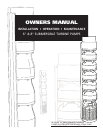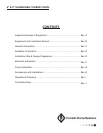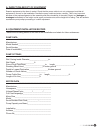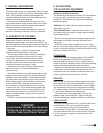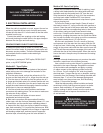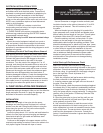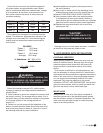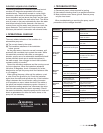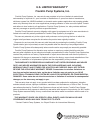
*CAUTION*
TAKE CARE TO PREVENT DAMAGE TO THE
CABLE DURING THE INSTALLATION.
F. ELECTRICAL INSTALLATION
When the cable is supplied on a reel, support the reel on
a piece of pipe laid across a pair of sturdy saw horses.
Locate the reel about 6 ft. from the well so that the cable
unwinds from the top.
Prevent the cable from scraping on the well casing
and avoid pinching the cable either in the pipe clamps or
between the riser pipe and well casing.
SPLICING POWER CABLE TO MOTOR LEADS
A waterproof splice must be made to connect the power
cable to the motor leads. An improperly made splice will
become a service problem. There are different materials
and methods that are used to make water tight
cable splices.
-Examples; by waterproof TAPE splice, RESIN CAST
splice, or by HEAT SHRINK splice.
Method #1- Taped Splice
1- Remove 10 in. from the outer jackets of the jacketed
cable, taking care not to damage the insulation of the
individual conductors.
2- Trim the motor leads, so that the yellow wire is 3 in.
shorter and the black wire is 3 in. longer than the red one.
3- Trim the wires of the cable so that the yellow wire is 3
in. longer and the black wire is 3 in. shorter that the red one.
4- Strip 1/2 in. of insulation from the end of each wire and
scrape the metal clean and thoroughly clean the surface
with solvent to insure a watertight splice.
5- Join like-colored wires with connectors and secure
connectors with staking pliers. Pull on wires to make sure
the wires are fi rmly crimped.
Fill each connector with solder to insure sound
mechanical and electrical joints.
6- Bind each connection with approved self-bonding
rubber tape, with the fi rst layer extending atleast 1 in. over
the insulation, and the second layer extending atleast 1
in. beyond the fi rst. Apply two layers of plastic insulating
tape, each extending 1 in. beyond the previous one. Bind
the three connectors together with one lapyer of approved
self-bonding rubber tape, and two layers of approved
electrical tape, all extending over the outer sheath if a
Method #2- Resin Cast Splice
Prepare the 3-conductor power cable for splicing, insert
a sharp knife blade between the cable jacket and lead
insulation and strip the jacket back 2.6” from the end.
Strip the cambric wrapping (if any) off of the conductors
and strip back rubber insulation 5/8” from the end.
Assemble the cable connectors and crimp them in place
using a crimping tool.
Cut off motor leads to equal length. Clean off ends of
the leads for about 12”, using a wet cloth with gasoline or
solvent. Clean the end of the power cable also. Insert the
three motor leads into corresponding holes in the bottom
of the rubber casing and push them several inches
out the top. Crimp the motor leads into corresponding
connectors, crimping the center one fi rst. Bend the cables
into line with the holes in the csing up until the connectors
are inside the holes about 1/4” from the top.
Mix the resin as directed. Cut off a corner of the bag
and squeeze all of the resin into the casing. With the roll
of tape on hand, fold the bag, and tape the top of the bag
snugly to the power cable until the resin runs out over the
top.This will assure maximum coverage of the resin and
minimize the size of the fi nished splice. When the resin is
fi rm to the touch, the splice may be immersed for testing.
REPAIR
Although cuts and abrasions may not puncture the cable
insulation, repair them in the following manner.
Use a solvent such as paint thinner or gasoline to clean
the cable in the area of damage. Roughen the surface
of the insulation with sandpaper and apply a coating
of rubber cement to the prepared surface and let dry
for 1/2 hour. Cut off a length of 3/4” wide vinyl plastic
electrical tape 1” longer than the cut or abrasion, and lay
it smoothly over the damage. Start binding the cable with
the same tape 1” in front of the damage lapping each
wrap halfway over the previous one, until the binding
extends 1” beyond the damage.
Wind the tape smoothly without wrinkles and avoid
stretching it unduly. Add three more layers in a similar
manner, each extending 1/2” beyond that beneath.
Apply a coating of rubber cement over the repair as an
additional bond and to improve the resistance to
oil and solvents.
WARNING
GROUND THE UNIT WHEN TESTING, FAILURE
TO GROUND THE UNIT PROPERLY CAN RESULT
IN SERIOUS OR FATAL SHOCK.
4



